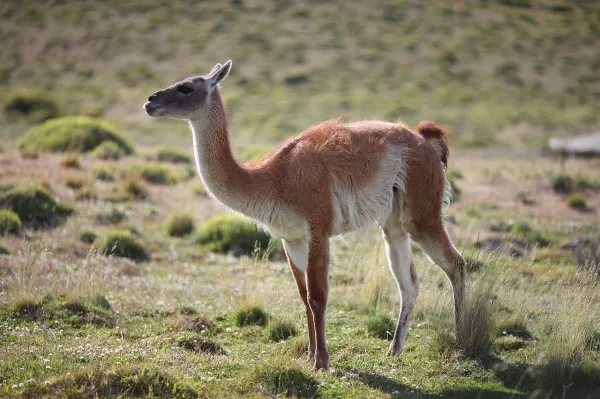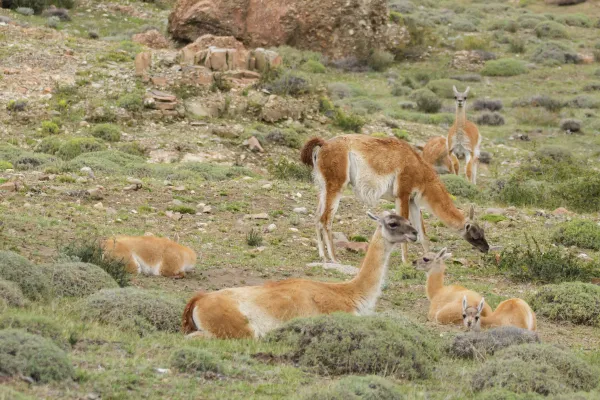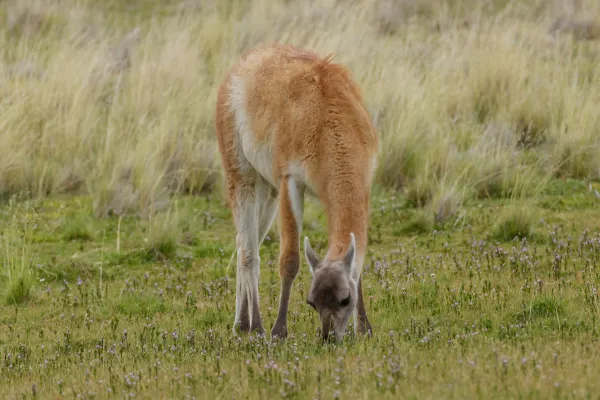Charles Darwin, the world-renowned naturalist and father of evolutionary theory, once referred to the guanaco (Lama guanicoe) as the “South American camel.” He wasn’t wrong—guanacos belong to the Camelidae family, which also includes camels and dromedaries from Africa and the Middle East, as well as South America’s llamas, alpacas, and vicuñas.
Due to their shared ancestry, these species exhibit many similar traits. For instance, unlike cows and other ruminants that have four stomach compartments, camelids like the guanaco only have three. Additionally, instead of hooves, they walk on two toes with nail-like hooves and soft padded soles, which are well-suited for rough and uneven terrain.
In this article, you’ll learn everything about the guanaco’s appearance, habitat, diet, and reproductive habits, especially as it remains one of the largest native mammals of Chile and Patagonia.

The guanaco is one of four camelid species native to South America, alongside the llama, alpaca, and vicuña. It is a wild animal and is considered the ancestor of the domesticated llama.
Slender build with a long neck and legs, giving it an elegant appearance.
Short, soft wool in varying tones: typically light brown on the body, white on the belly, inner legs, and neck, and dark gray on the head.
A small, curved tail.
Medium-sized: measures between 90 cm to 1.2 meters at the shoulder.
Consistent coat color across individuals, unlike llamas, which come in white, black, gray, or brown.
Two primary subspecies:
Lama guanicoe guanicoe: Found in Peru and northern Chile.
Lama guanicoe cacsilensis: Larger in size, found in southern ranges.
Guanacos live in small herds typically consisting of one dominant male, 4–20 females, and their young (called "chulengos"). They mark their territory using dung piles and can run up to 60 km/h when escaping predators.

The guanaco is highly adaptable and has the widest range among all South American camelids. It prefers arid or semi-arid environments, especially those surrounding the Andes Mountains, from Peru to the southern tip of Patagonia.
Grasslands
Shrublands
Mountainous regions
Guanacos can be found at sea level up to 4,000 meters in elevation and are well-suited to endure both daily and seasonal temperature fluctuations.
Guanacos are herbivorous generalists, meaning they are not picky about what they eat. This is likely an adaptation to their broad geographic distribution and diverse environments.
Grasses (graminoids)
Herbs
Low shrubs
Occasionally, lichens and succulents, particularly during dry periods
Guanacos tend to graze most actively from midday into the afternoon, then seek shelter in shrubs or protected areas at night.

As with many camelids, guanaco herds follow a dominant male-led structure, especially during mating season (late spring). At around three years of age, young males leave the herd, often forming bachelor groups or living alone.
Mating Season: Late spring
Gestation Period: ~11 months
Offspring: Usually one calf, capable of walking within 2–3 days
Weaning: Begins eating grass at ~1 month, fully weaned around 6 months
Sexual Maturity:
Females: ~1 year
Males: ~3 years, but must establish their own group
Seasonal Behavior:
In winter, previously territorial herds become more social and form large migratory groups of hundreds.
The guanaco is a fascinating species that reflects the resilience and adaptability of South American wildlife. With its wide range, social complexity, and remarkable speed and endurance, it plays a vital ecological role in the regions it inhabits. As a wild ancestor of the llama, understanding the guanaco also offers insight into the domestication and evolution of camelids across the Andes.
If you're curious about the differences between llamas and alpacas, don't miss our related article: Llama vs. Alpaca: What Sets Them Apart.
Bibliography
Biodiversity Information System of the National Parks Administration, Argentina. Lama guanicoe. Available at: https://sib.gob.ar/especies/lama-guanicoe?tab=info-general
Torres, Hernán. Distribution and Conservation of the Guanaco: Report. (1985). International Union for Conservation of Nature and Natural Resources (IUCN), Gland, Switzerland and Cambridge, UK.
Gilmore, R. M. (1950). Fauna and Ethnozoology of South America. United States: U.S. Government Printing Office.
Ojasti, J. (1996). Wildlife Utilization in Latin America: Current Situation and Prospects for Sustainable Management. Italy: Food and Agriculture Organization of the United Nations.
animal tags: Guanaco
We created this article in conjunction with AI technology, then made sure it was fact-checked and edited by a Animals Top editor.